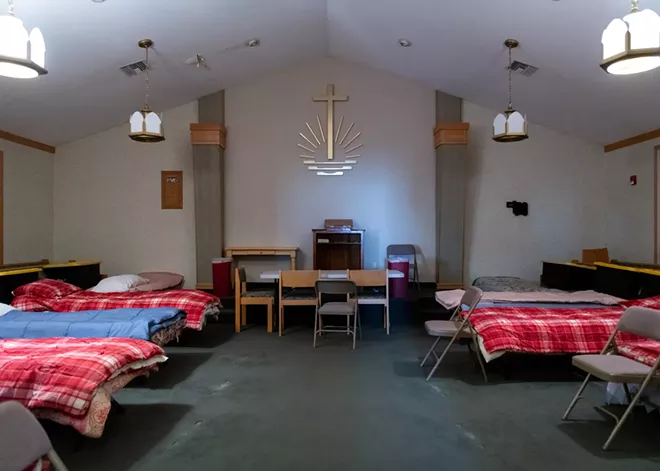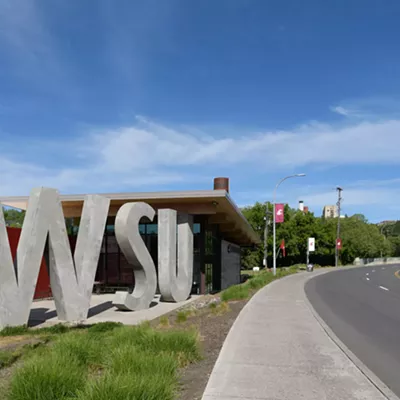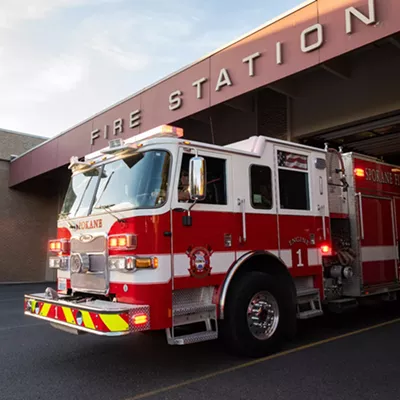
The city of Spokane's approach to homeless shelters may be moving in a new direction.
On Thursday, the City Council voted unanimously to approve a $342,000 contract extension with Jewels Helping Hands, a nonprofit homeless service provider, to operate three local churches as homeless shelters serving about 20 people each through the end of August.
The extension makes a temporary program started under a state of emergency slightly more permanent, and offers a hint at what the city's long-term approach to sheltering may look like going forward.
Jewels and other volunteers started the project of using churches as shelters this winter because of concerns about the city's lack of a plan for emergency warming shelters. When a cold snap struck in January, Spokane Mayor Lisa Brown declared a state of emergency and agreed to pay Jewels to operate the shelters for a week. This was later extended to the end of February due to continued cold weather.
Instead of a first come, first served model, Jewels uses a referral system to screen guests and provide transport to and from shelters. The three churches volunteering to let Jewels use their buildings are Morning Star Baptist, Knox Presbyterian and the New Apostolic Church, which was previously vacant.
(Morning Star Baptist and New Apostolic are currently hosting 30 guests each because Knox Presbyterian is temporarily offline with a plumbing issue. When the plumbing is fixed, each church will house 20 people.)
SCATTERED SITE
The church shelters are an example of the "scattered site" model, which involves a number of smaller homeless shelters spread throughout a city. The goal is to minimize impact to neighborhoods and maintain a more orderly environment for guests.
The scattered site approach is a contrast to the "congregate shelter" model, which is exemplified by the city's Trent Avenue homeless shelter — a converted industrial warehouse that had 350 beds before being reduced to 250 at the start of this month.
"I have been a fan of the scattered site model since day one," City Council President Betsy Wilkerson said on Thursday. "A neighborhood can absorb 20, 30, maybe 40 people. But a neighborhood cannot absorb 300 people at one time."
During a series of reports from neighborhood councils to the City Council on Monday, Chief Gary Park Neighborhood Council chair Luc Jasmin III said crime related to the Trent shelter and a lack of engagement around the shelter's future are major neighborhood concerns.
In a justification form for the Jewels contract, the city's Community, Housing and Human Services department wrote that the beds at the Trent shelter (also known as TRAC) were reduced to "work toward de-congregated shelter options." The department said the church beds are necessary to ensure shelter space as the city works to wind down the Trent shelter — one of Brown's long-term goals.
The CHHS department said a "regional shelter audit" will be completed by the end of Jewels' contract, and the results of the audit will be incorporated into final decisions about the best model for shelters going forward.
'POSITIVE IMPACTS'
Barry Barfield, the administrator of the Spokane Homeless Coalition, spoke in favor of the church shelter model at the council's special legislative meeting on Thursday, highlighting the neighborhood support and low cost relative to other shelter contracts. (The city is currently paying Salvation Army $750,000 per month to operate the beds at the Trent shelter.)
"It's a win for the mission of the churches to bring people off the street and give them a place to stay, it's a win for the guests having a dignified place to lay their heads," Barfield said.
City Council member Kitty Klitzke said she visited one of the churches earlier this year, and was impressed by its low impact.
"I think it's a really good system," Klitzke said. "If we could expand on that idea I think it would be a really good thing."
Klitzke said she hasn't heard any complaints from the neighborhood.
"I hear really good feedback from the volunteers there, too. I don't think it's the same kind of vibe at TRAC," Klitzke said.
Sharyl Brown, a Jewels employee working at the New Apostolic Church, told the Inlander in January that the small size of the church shelters had made things easier to manage and given her time to give guests individual attention and help connect them to services.
"If it were a larger scale, if we were packed, I wouldn't have any time to do that," Brown said.
Jewels' contracts with the city for the warming shelter project have faced several hurdles.
In January, Garcia and her husband, the treasurer for Jewels, were mysteriously blocked from emailing city email accounts.
City IT staff said it was a random technology error from a third-party security service. But the timing was unfortunate, and caused confusion and stress as Jewels wondered why their emails seeking payment weren't being responded to. The issue wasn't resolved until early March.
The City Council had planned to approve the six-month extension on Monday, but the plan was disrupted when a public speaker mentioned the plumbing issue at Knox Presbyterian. Council members weren't aware of this, and worried Jewels would no longer be able to provide 60 beds.
After a period of debate and confusion, City Council members decided to defer the vote to Thursday, despite concern about further disruption to Jewels' payments.
"I understand that the city hasn't always been the best at paying on time with certain groups," Council member Jonathan Bingle said. "But also, when something like this happens and there's a significant reduction... if it had happened at TRAC we would want to know why we weren't informed."
Garcia showed up towards the end of the meeting to try to explain that Jewels would still be able to provide 60 beds, but the meeting had already been gaveled out. On Thursday, council members apologized for the delay, and praised Garcia's work on the project.
"I think the work has just been tremendous," Council member Paul Dillon said. "I think the scatter site model really works. We've seen so many positive impacts."

























